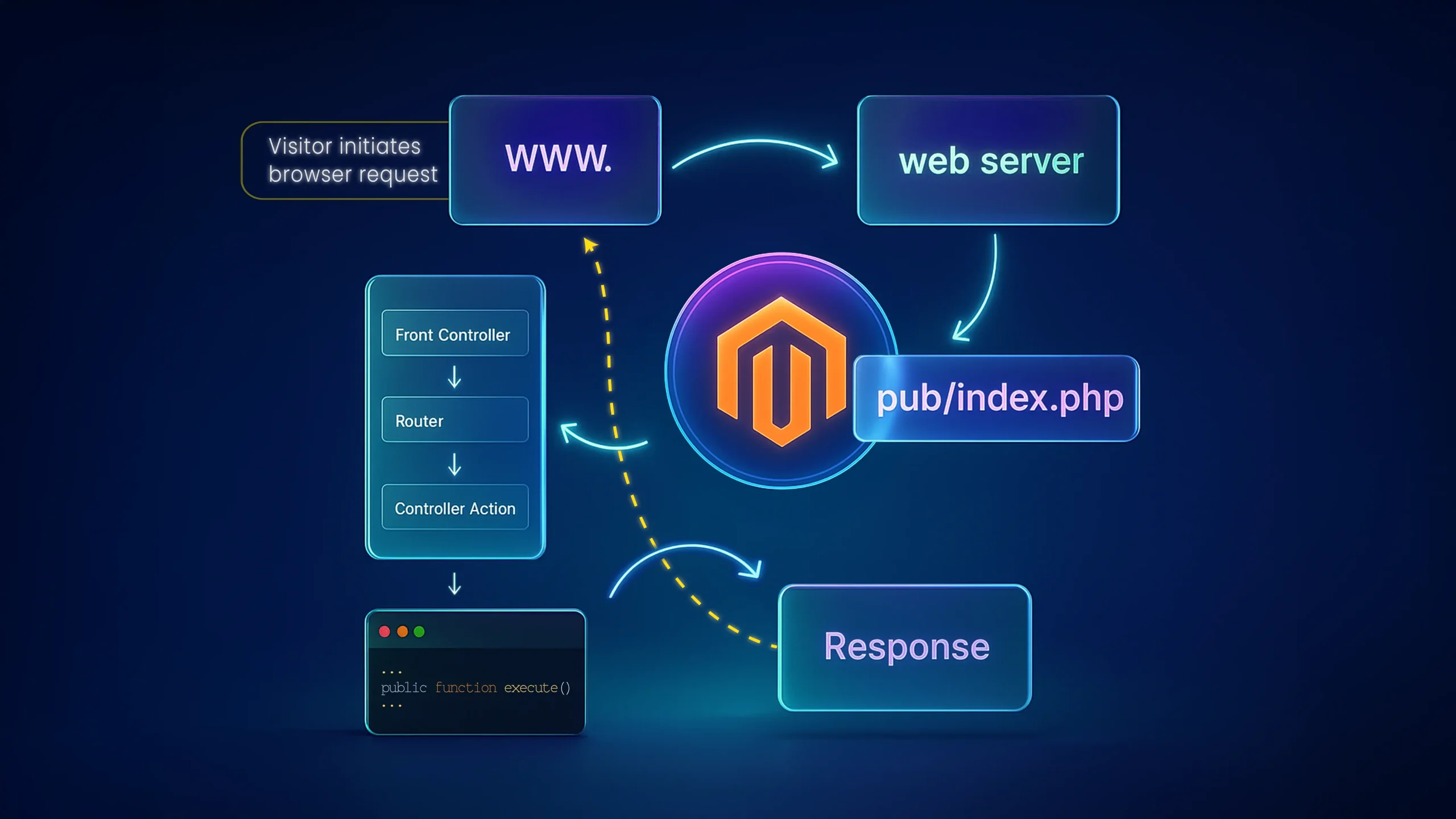- BigCommerce is fully hosted and it comes with fixed pricing plans.
- Adobe Commerce offers better customizability that requires technical expertise.
- Adobe Commerce relies on extensions for multi-channel selling, while the feature comes built-in with BigCommerce.
- Adobe Commerce is designed for enterprise-level businesses while BigCommerce is a great option for small to mid-sized companies.
- BigCommerce offers 24/7 support for all pricing plans.
- Adobe Commerce offers more in-depth SEO customizations than BigCommerce.
At the moment, the eCommerce industry is more competitive than ever. Choosing the right platform for your online store can be one of the biggest factors that decide the fate of your business. Adobe Commerce (Magento) and BigCommerce are two of the most popular eCommerce platforms used by millions across the globe. But the audience for these two varies!
What is BigCommerce?
BigCommerce is a fully-hosted cloud-based SaaS (Software-as-a-Service) platform that comes with built-in features to build modern eCommerce stores. From customizable templates to multi-channel selling and advanced analytics, this platform offers everything that you need to create a high-performing online store. Moreover, it also offers enterprise-grade capabilities that make it a great pick for small businesses to large enterprises.
What is Adobe Commerce?
Adobe Commerce (formerly known as Magento) is an enterprise-level eCommerce platform that offers unmatched scalability and state-of-the-art features. It is the premium, enterprise-level version of Magento Open Source that comes with more advanced features, better security, and support compared to Magento Open Source.
Why is Magento now called Adobe Commerce?
Well, you aren’t the only one asking this question. Confusion between these two is pretty common. So, here’s a quick history lesson to give you more clarity before we go ahead with the comparison.
Adobe acquired Magento in 2018, and the platform was rebranded as Adobe Commerce. However, the core Magento platform is kept intact without any changes. Basically, there are two versions:
- Magento Open Source (free, self-hosted version)
- Adobe Commerce (paid enterprise version, also available as Adobe Commerce Cloud)
If you don’t need the top-end features and customizability and are looking for a traditional Magento experience, Magento Open Source is the way to go. But for advanced features with more complexity, Adobe Commerce makes more sense with cloud hosting and AI-driven insights.
Adobe Commerce vs BigCommerce: The Battle of the Best
Choosing one over the other platform is never easy as both platforms come with a boatload of features, functionalities, and benefits. But there is an answer to the Magento vs BigCommerce debate, and it depends on your specific business requirements, growth opportunities, and technical expertise. In this blog, we’ll help you choose one of these feature-packed eCommerce platforms by comparing them against each other in terms of customization, scalability, pricing, security, and whatnot!
So, let’s dive in.
1. Pricing: Fixed Subscription vs. Custom Costs
While Adobe Commerce and BigCommerce offer completely contrasting pricing models, the cost can still be a decisive factor in choosing a digital commerce platform.
BigCommerce: Transparent, Fixed Pricing
As a fully hosted eCommerce platform, BigCommerce has straightforward, subscription-based pricing, which makes it easy to calculate your expenses.
| Plan | Price (billed annually) | Annual Sales Limit |
| Standard | $29/month | Up to $50K online revenue |
| Plus | $79/month | Up to $180K online revenue |
| Pro | $299/month | Up to $400K revenue |
| Enterprise | Custom pricing | Best for businesses with $1M+ online revenue |
New users get a 15-day free trial.
All plans include hosting, security, and other critical features.
There is no transaction fee involved, but once the sales limit for the current plan is exceeded, you will be automatically upgraded to the next tier.
Adobe Commerce: Custom Pricing Based on Different Factors
There is no official fixed pricing for the Adobe Commerce enterprise plans. Instead, various variables decide the total cost.
- Gross Merchandise Value (GMV): Total annual revenue from online sales.
- Business size and complexity: Including required features and integrations.
- Hosting and infrastructure: Depends on your pick between Adobe Commerce Cloud or a self-hosted solution.
Adobe Commerce comes with three different pricing packages:
- Adobe Commerce Pro: This is an all-in-one solution that includes hosting, security, and support. By submitting your business portfolio, you get a custom quote.
- Adobe Managed Services: Designed for larger businesses, this package delivers advanced support infrastructure while being pricier than Commerce Pro.
- Magento Open Source: The Magento Open Source is completely free to download, but you need to consider the cost of development, hosting, and customization.
Additional Costs for Adobe Commerce Users:
- Hosting: If you decide to self-host, the hosting charges are applicable.
- Themes: The premium themes on the Adobe Marketplace add to the expenses.
- Extensions: The cost can increase with paid extensions for added functionality.
- Development: The cost of hiring a developer or a team to make customizations.
2. Ease of Use
When it comes to ease of use, BigCommerce is hands-down the winner as it is designed for beginners. But you need more technical expertise to use Adobe Commerce.
BigCommerce: Easy to Use
Being a fully hosted platform, BigCommerce handles a number of technical aspects like hosting, security, and updates on your behalf. Thanks to a drag-and-drop page builder and intuitive dashboard, BigCommerce stores are easy to launch and manage.
Adobe Commerce: Developer-Oriented
On the other hand, Adobe Commerce is more developer-oriented. While it comes with a steeper learning curve, it offers more control over your online store. To build a store on Adobe Commerce, you need knowledge of coding, hosting, and third-party integrations.
Verdict: If you need an easy and quick setup, BigCommerce is the clear winner. But if you have access to an efficient development team and want full control over your store, Adobe Commerce is the right pick.
3. Customization & Design
Customization is undoubtedly one of the factors that can help deliver a better user experience and brand identity.
BigCommerce: Pre-Built Simplicity
You get 12 free themes and 190+ premium themes with BigCommerce. Leveraging the platform’s built-in drag-and-drop page builder, you can edit layouts, colors, and fonts without even writing a single line of code. But it lacks in customizability (especially in mobile design).
Adobe Commerce: Full Creative Freedom
Completely contrary to BigCommerce, Adobe Commerce gives you a free hand when it comes to customizations. Not only can you build your own themes from scratch, but you can also modify existing ones. The 10+ pre-built themes on the Adobe Commerce Marketplace can be further customized through coding. But customizations can be expensive as they involve additional resources.
Verdict: For those looking for unlimited control over their eCommerce store, Adobe Commerce is the way to go, and for the ones that prefer ease of use, BigCommerce is the obvious choice.
4. Sales & Marketing Features
The sales tools are at the core of any digital commerce solution, and both Adobe Commerce and BigCommerce come on top, delivering powerful options.
BigCommerce: Built-in Convenience
You get several intuitive out-of-the-box sales features with BigCommerce:
- Abandoned cart recovery (available on Pro & Enterprise plans)
- 65+ payment gateways (Stripe, PayPal, Apple Pay, etc.)
- Multi-channel selling (Amazon, eBay, Facebook, Instagram)
- SEO-friendly tools (integrated Google Analytics & Search Console)
Adobe Commerce: More Advanced With Expansion Potential
Instead of built-in features, Adobe Commerce relies on extensions to deliver highly advanced sales features. From multi-store management to B2B pricing, personalized promotions, and more, the sky is the limit for Adobe Commerce stores.
Verdict: For businesses that need ready-to-use sales tools, BigCommerce is a safe choice. Adobe Commerce is better for businesses that want more advanced setups and better flexibility.
5. Scalability
Handling high volumes of traffic and sales is one of the most crucial aspects of a growing business as failing to do so can lead to downtimes, dissatisfied users, higher bounce rates, and card abandonment.
BigCommerce: Scalable with Unexpected Plan Upgrades
BigCommerce is well-optimized to handle your business growth and scalability minus any complicated upgrades. But the revenue caps on the platform can result in unexpected plan upgrades, hindering your operations and workflow.
Adobe Commerce: Built to Handle Growth
Since Adobe Commerce is dedicated to enterprise-grade businesses, it is well-equipped to handle huge traffic and transaction volumes without any friction. On the other hand, if you use Magento Open Source, you can upgrade your hosting as required, handling growing sales and traffic.
Verdict: If scalability is your concern, Adobe Commerce makes the most sense as it offers more flexibility and support for rapidly growing businesses.
6. Security & Compliance
To run an online store successfully, compromising on security is never an option. While both platforms offer security features, they differ in their approach.
BigCommerce: Fully Managed Security
With BigCommerce, you get all security measures built-in. From SSL certificates and PCI compliance to automated security updates, DDoS protection, GDPR compliance, fraud prevention, and many more, merchants get fully managed security.
Adobe Commerce: Self-Managed or Cloud-Managed Security
Adobe Commerce Cloud offers automated PCI compliance, security updates, and a Web Application Firewall (WAF), which ensures a secure setup without much manual work. But if you choose Magento Open Source, you have to do manual security checks, install external security extensions, and get separate SSL certificates, which makes it more complex to manage.
Verdict: For hassle-free security, BigCommerce is a better choice while Adobe Commerce Cloud also offers automated security management. But Magento Open Source demands technical expertise.
7. Customer Support
When it comes to eCommerce platforms, customer support is something you cannot compromise on. Without the right support, you may get stuck on a problem that costs you customers! Make sure to choose a platform that offers you comprehensive assistance.
BigCommerce: 24/7 Support for All Users
You get 24/7 support with BigCommerce. From emails to live chat and phone, it offers a wide range of options for merchants to ensure prompt assistance for any issues. You also get access to BigCommerce’s knowledge base, community forum, and help center for easier troubleshooting.
Adobe Commerce: Community-Driven Assistance
Unlike BigCommerce, you get limited dedicated support from Adobe Commerce. Merchants have to rely on community-driven support and find solutions to problems through documentation, forums, and third-party developers. While the enterprise users do get the Adobe premium support, the Magento Open Source users are left with only external assistance.
Verdict: BigCommerce ensures faster and more straightforward troubleshooting, while it can be more complex with Adobe Commerce. While you get more flexibility with Adobe Commerce, the lack of dedicated customer support for all users makes it a tougher choice for businesses that need fast, hands-on customer service.
8. Multichannel Selling: Selling Beyond Your Website
Gone are those days when selling products on your own website got you traffic and sales! At the moment, businesses have to sell across multiple different channels to survive and succeed in the industry. From marketplaces to social media and in-person sales, there are various channels to take care of.
BigCommerce: Built-in Integration for Multi-Channel Selling
With BigCommerce, you get out-of-the-box integrations with various platforms and channels:
- Marketplace selling through Amazon, eBay, and Walmart.
- Social commerce selling through Facebook, Instagram, and TikTok.
- Product listings through Google Shopping integration.
- POS (Point-of-Sales) integrations with Clover, Square, etc.
Adobe Commerce: Extension-Based Multi-Channel Selling
Adobe Commerce also offers multi-channel selling by integrating with various platforms. However, the integrations require extensions, unlike BigCommerce. With Adobe Commerce, you have to use third-party modules to connect your store to marketplaces like Amazon and eBay or social media platforms like Facebook, TikTok, and Instagram. This adds to the cost and setup time.
Verdict: If you want built-in multi-channel capabilities minus any complex, manual work, BigCommerce definitely wins the battle.
9. SEO Capabilities
When it comes to any online platforms, including eCommerce stores, SEO strategy is vital. Organic visibility and traffic always come in handy to leave a lasting impression and get more sales without spending fortunes on marketing. Let’s see how Adobe Commerce and BigCommerce fare against each other in the battle of SEO.
BigCommerce’s SEO Features:
- Better keyword optimization through customizable URLs.
- Built-in SSL certificates ensure better ranking as Google favors secure sites.
- Delivers faster loading times through automated image optimization.
- Unmatched user experience because of mobile-friendly themes.
Adobe Commerce’s SEO Features:
- Offers complete control over indexing and site structure.
- Delivers better rankings through advanced metadata customization.
- Offers support for canonical tags and structured data.
- Ensures more flexibility but needs manual setup.
Verdict: Tie If you are looking for easy-to-perform SEO optimization, BigCommerce is a better choice. On the other hand, for businesses that need more in-depth control over their SEO settings, Adobe Commerce offers more flexibility.
10. App & Extension Marketplace: Expanding Your Store’s Capabilities
For every single online store out there, apps and extensions play a crucial role as they help with added features and functionalities missing from the platform’s built-in capabilities.
Apps for BigCommerce
With more than 600 apps in its marketplace, you can get various apps to add critical functionalities to your store with BigCommerce.
- Mailchimp and Klaviyo for marketing.
- ShipStation for advanced shipping integrations.
- ReCharge for efficient subscription management.
Extensions for Adobe Commerce
Being one of the leading providers across the globe catering to enterprise-grade businesses, Adobe Commerce offers way more options when it comes to extensions in the Magento Marketplace. With 5000+ extensions, the platform enables developers to make advanced customizations. However, many extensions require paid licenses.
Verdict: When it comes to apps and extensions, Adobe Commerce is the clear winner. If your business needs customizable and highly specific features, Adobe Commerce is the way to go.
Final Verdict: Which Platform is Best for You?
| Business Type | Best Choice |
| Small Businesses & Startups | BigCommerce |
| Mid-Sized Businesses Scaling Up | BigCommerce |
| Enterprise-Level Brands | Adobe Commerce |
| Stores That Need Advanced Customization | Adobe Commerce |
| Businesses with Multi-Channel Selling | BigCommerce |
| Businesses Focusing on SEO | Tie |
| Stores Needing More Third-Party Extension Support | Adobe Commerce |
Conclusion
There is no winner or loser when it comes to choosing a platform for your eCommerce store. While all platforms have their advantages, they all come with their own sets of cons too! Picking one between Adobe Commerce and BigCommerce fully depends on your unique requirements, objectives, and goals. However, this comparison between the two platforms can help you make a more informed decision, helping your business grow and succeed.











